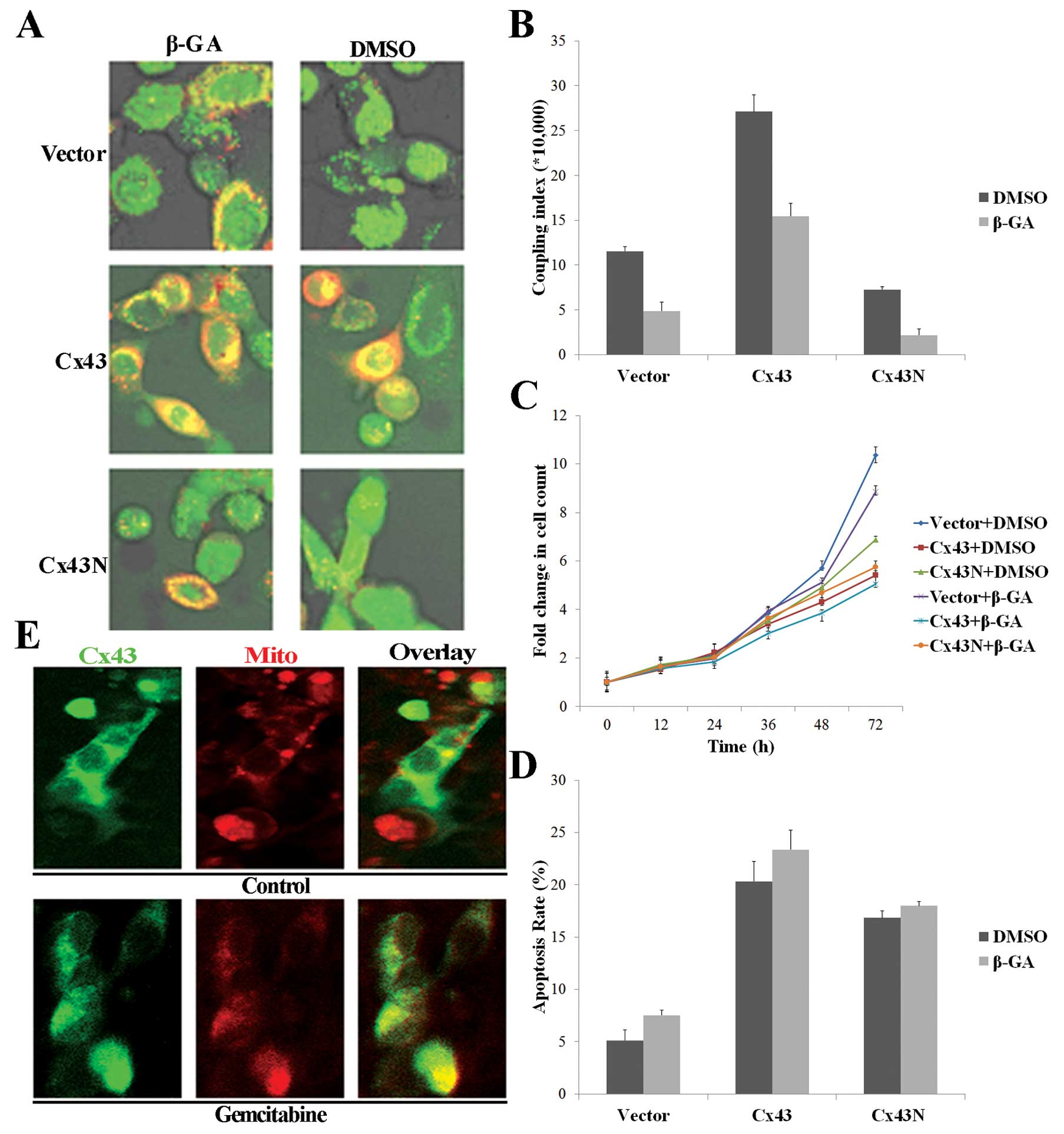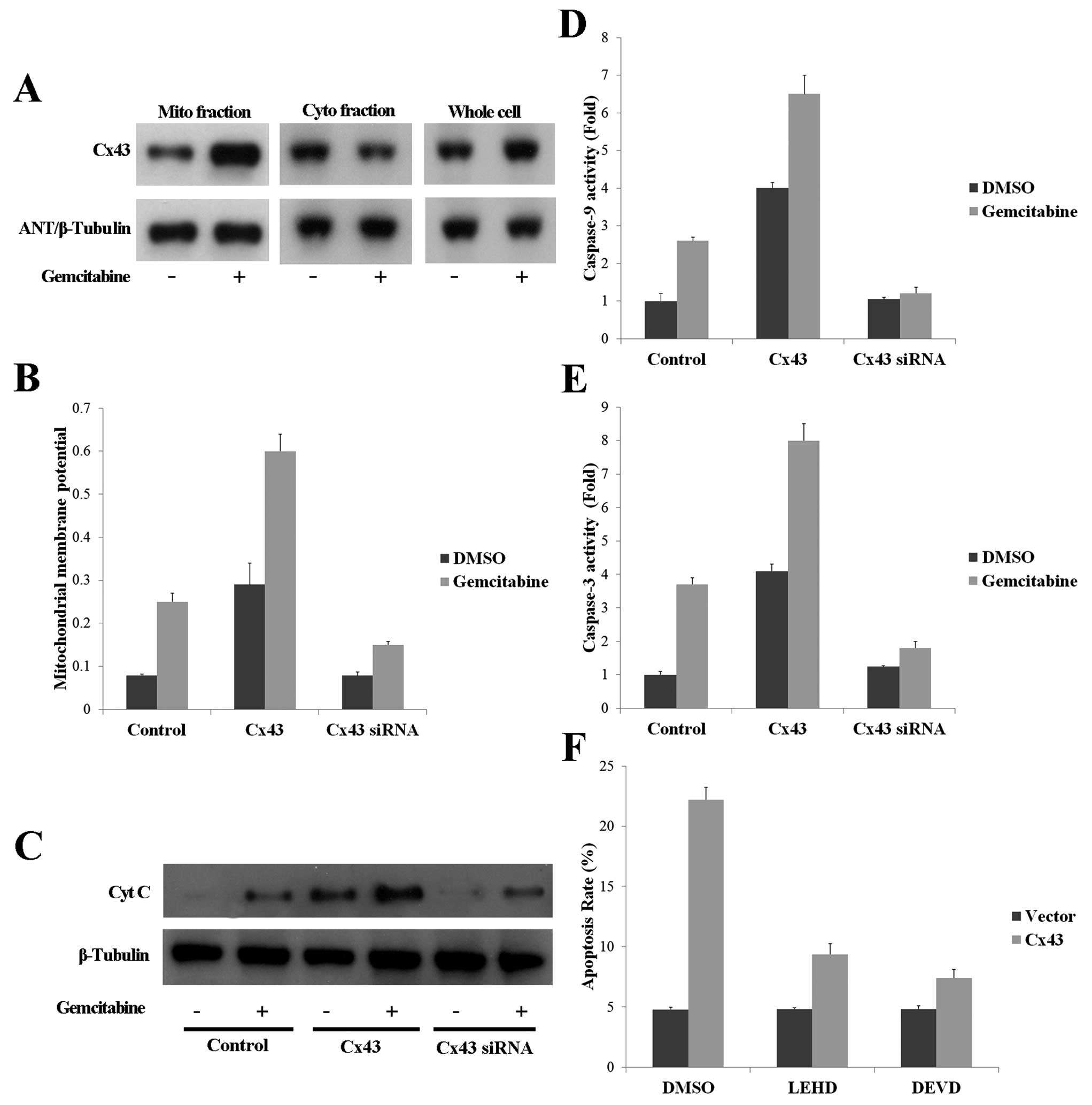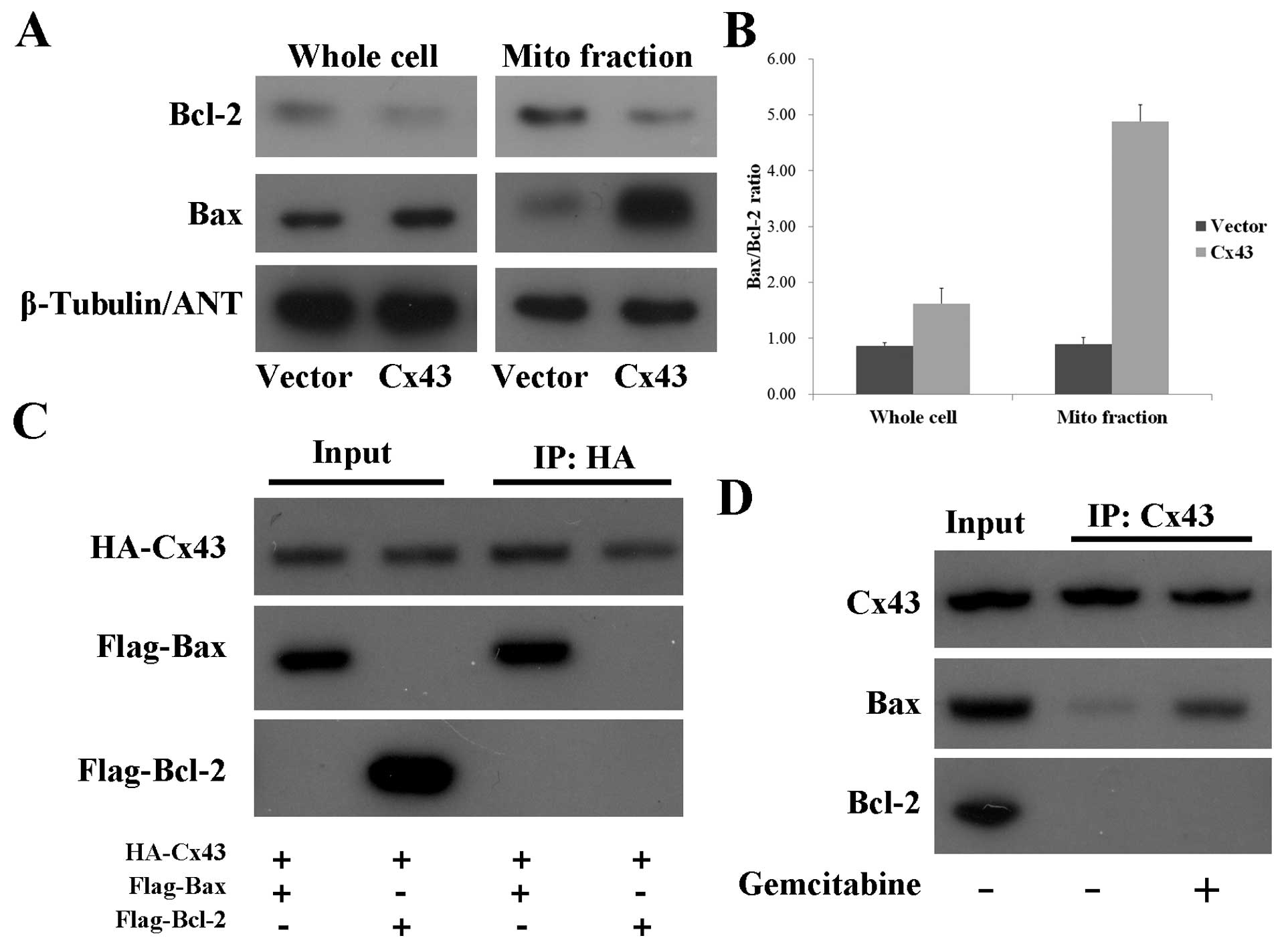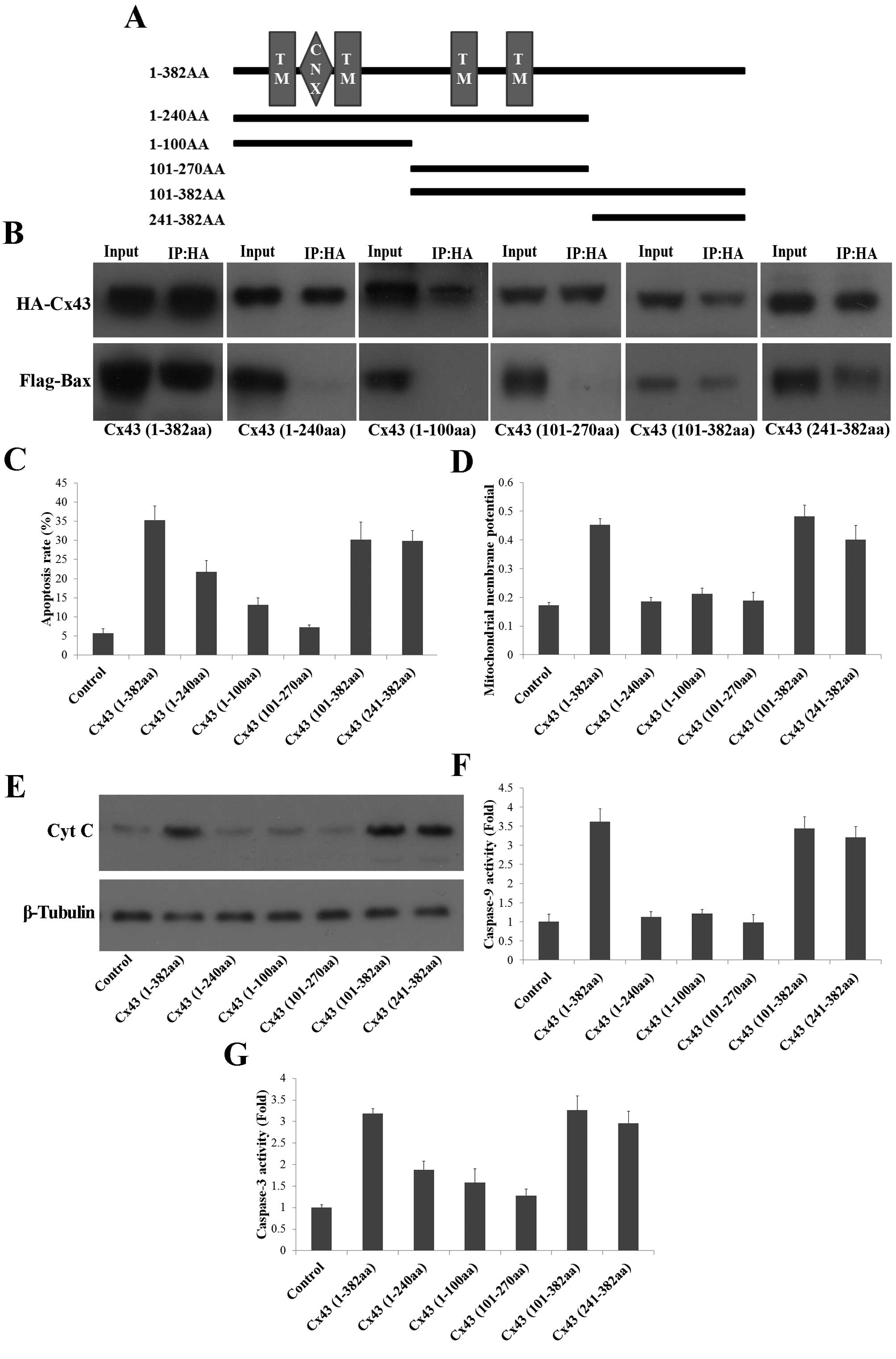Introduction
Pancreatic cancer is the fourth most frequent cause
of cancer related mortality, with a 5-year overall survival of less
than 5%. In the United States, approximately 42,470 individuals are
diagnosed with this condition and 35,240 die from the disease each
year (1). To date, tumor resection
has remained the only curative therapy for pancreatic carcinoma.
Irradiation and chemotherapy do not have a significant therapeutic
effect on pancreatic cancer (2).
Therefore, pancreatic cancer still represents a therapeutic
challenge in oncology.
Connexins (Cxs) are encoded by a multigene family;
to date, 21 different Cx genes have been identified. Gap junctions
(GJs), which are composed of Cx proteins, allow the direct exchange
of small molecules between adjacent cells (3). A previous study showed that Cxs exert
their function through a GJ-independent pathway. The underlying
mechanisms of a GJ-independent pathway mainly involve protein
interactions (4). The
dysregulation of Cx expression has been associated with
carcinogenesis of the lung, breast, prostate, liver, stomach and
colon. Cxs are involved in the regulation of tumor proliferation,
apoptosis, invasion and metastasis (5). Connexin 43 is the major isoform in
the pancreas, yet few studies have addressed its role in pancreatic
cancer (6). We performed this
study in order to unravel the mechanism of the Cx43-regulated
apoptosis of pancreatic cancer.
Materials and methods
Cell culture, plasmids and materials
Human pancreatic cancer cells (BxPC-3, SW1990,
PaTu8988, PANC-1, AsPC-1 and CFPAC-1) were grown in high glucose
DMEM or RPMI-1640, supplemented with 10% (v/v) FBS at 37°C with 5%
CO2. The siRNAs against Cx43 oligonucleotides were
synthesized by Ambion (Grand Island, NY, USA) with the sequence
5′-GAUGAUAACCAGAA UUCTA-3′. Non-silencing control siRNA was
synthesized using scrambled sequence as the negative control (NC).
The dominant-negative Cx43 mutant (Cx43N) was constructed by
deletion of amino acids 130–136 from the cytoplasmic loop. This
mutant is effective as a dominant-negative inhibitor of GJs. The
transfection of siRNA or plasmids was applied using Lipofectamine
2000 (Invitrogen, Carlsbad, CA, USA) according to the
manufacturer’s instructions.
Assay for GJ intercellular
communication
The GJ assay protocol was employed based on a
modification of the methods described by Goldberg et al
(7). Donor and recipient cell
populations were differentially labeled for 30 min with the
GJ-permeable dye, calcein AM, and the lipophilic dye,
DiIC18 (Molecular Probes, Eugene, OR, USA), in DMEM
containing 10% FBS, respectively. After washing, donor cells were
trypsinized and added to acceptor cells at a 1:5 (donor: acceptor)
ratio for 3 h at 37°C. Co-cultures were harvested and subjected to
FACS analysis. If GJ intercellular communication (GJIC) occurred,
calcein was transferred from donor cells (green) to recipient cells
(red). Thus, double-labeled cells represented the communicating
cells in this assay. Cytometric data were expressed in terms of the
coupling index (coupled acceptor cells/total potential acceptor
cells) per donor cell and were plotted as the means ± SEM of 3
experiments.
Analysis of mitochondrial
depolarization
JC-1 (Invitrogen) was employed to measure
mitochondrial depolarization in BxPC-3 cells. Mitochondrial
depolarization was indicated by a decrease in the red/green
fluorescence intensity ratio. Cells were incubated with 5
μg/ml of JC-1 at 37°C for 15 min and then analyzed by
fluorescence-activated cell sorter.
Co-immunoprecipitation
For immunoprecipitation, 200 μg of cell
lysate were incubated with 25 μl each of agarose A and G
(Invitrogen) in 500 μl total volumes for 1 h.
Immunoprecipitating antibody was added with an additional 3 h of
incubation at 4°C with constant rotation. The complex was washed 3
times. It was then resuspended in SDS loading buffer. After
boiling, the supernatant was loaded for western blot analysis. The
total protein in the input lysate was approximately 1/10 of the
amount used for immunoprecipitation. The antibodies used were: Cx43
(Sigma, St. Louis, MO, USA), Bax, Bcl-2 and GAPDH (Cell Signaling
Technology, Danvers, MA, USA).
Statistical analysis
All experiments were performed in triplicate and the
results are expressed as the means ± SEM. The data were analyzed
with the Student’s t-test or by one-way analysis of variance
(ANOVA) and P≤0.05 denoted a statistically significant
difference.
Results
Cx43 induces apoptosis of pancreatic
cancer cells
We examined the proliferation rates in pancreatic
cancer cells transfected with Cx43. Cell growth was significantly
inhibited in the presence of Cx43. Of note, growth inhibition was
more apparent in SW1990 and BxPC-3 cells, but not in PaTu8988 cells
(Fig. 1A–C). The possible reason
was that PaTu8988 cells had a relatively higher level of Cx43
(Fig. 1D). We then tried to use
siRNA to rescue the growth inhibition induced by Cx43. Growth
inhibition was recovered in the cells co-transfected with DNA and
Cx43 siRNA. The Cx43 knockdown promoted cancer cell growth
(Fig. 1E). As Cx43 is involved in
regulating apoptosis in multiple cancers, we speculated that Cx43
may be a pro-apoptotic gene in pancreatic cancer. The apoptotic
rates were approximately 20–30% when the pancreatic cancer cells
were transfected with Cx43 (Fig.
1F). Gemcitabine is a widely-used drug for the first-line
therapy of pancreatic cancer. In this study, we found that level of
Cx43 positively correlated with the apoptosis induced by
gemcitabine (Fig. 1G). These
results suggest that Cx43 plays an important role in regulating the
apoptosis of pancreatic cancer cells.
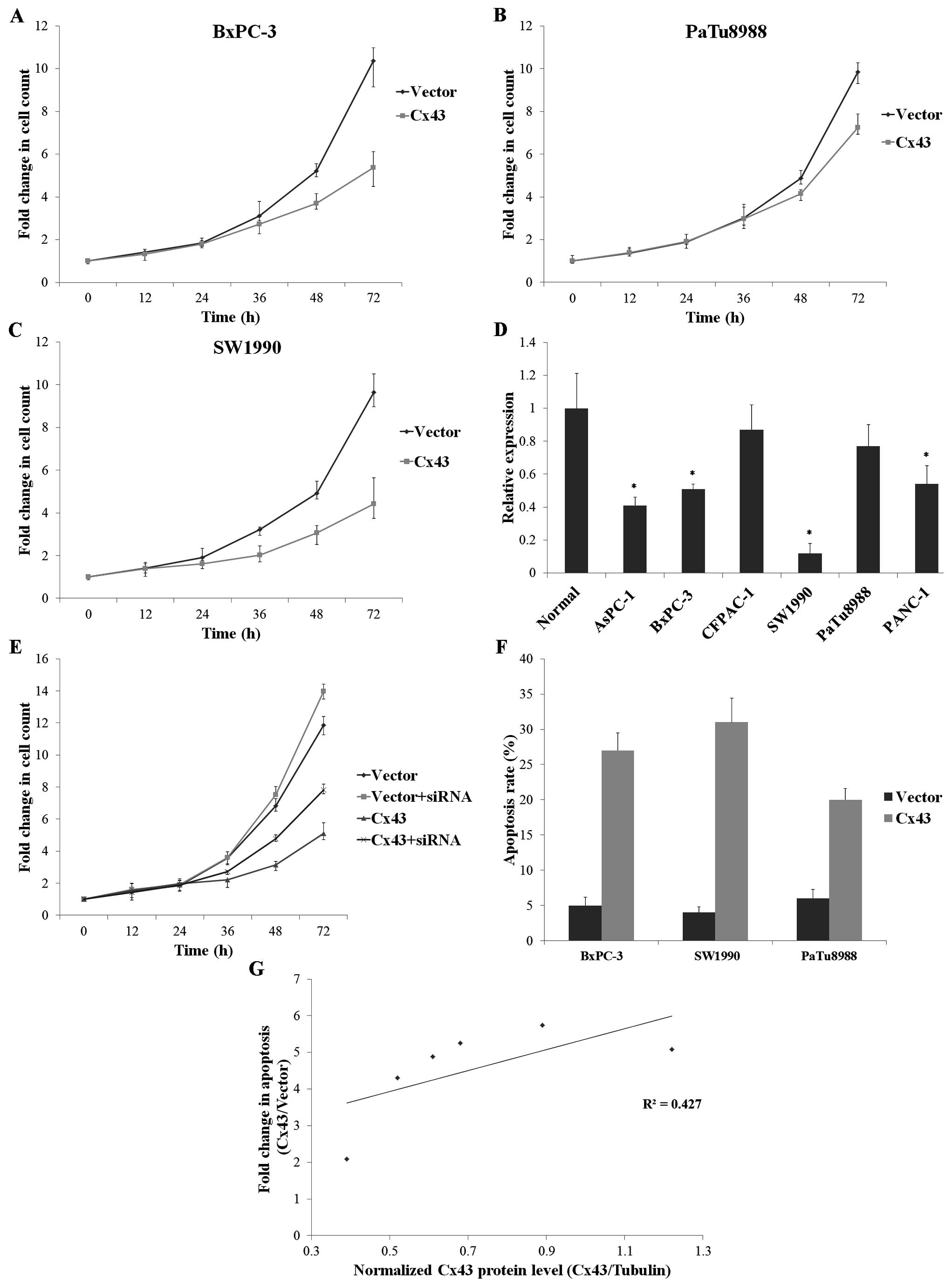 | Figure 1Cx43 inhibits the growth of human
pancreatic cancer cells. (A–C) Cell proliferation was analyzed in
BxPC-3, PaTu8988 and SW1990 cells. Cells were transfected with Cx43
or the control plasmid. Cell numbers were recorded for 3 days. (D)
Analysis of relative Cx43 expression in the pancreatic cancer cell
lines, AsPC-1, BxPC-3, CFPAC-1, SW1990, PaTu8988 and PANC-1. (E)
Cell proliferation was analyzed in BxPC-3 cells with Cx43 plasmid
or siRNA. (F) Apoptotic rate was assessed in BxPC-3, SW1990 and
PaTu8988 cells by Annexin V/PI assay. (G) The ordinate shows
changes in apoptotic rate. The abscissa was normalized to Cx43
protein levels. Dots represent the average changes in AsPC-1,
BxPC-3, CFPAC-1, SW1990, PaTu8988 and PANC-1 cells. Data represent
the means ± SEM values from at least 3 separate experiments. |
Tumor-suppressive function of Cx43 occurs
via a GJ-independent pathway
It is well known that Cx43 exerts its function
through a canonical GJ-mediated pathway. We therefore investigated
whether GJ is necessary for Cx43 tumor-suppressive function.
18β-glycyrrhetinic acid (β-GA) was used for GJ inhibition (Fig. 2A and B). With β-GA treatment, Cx43
still inhibited the growth and induced the apoptosis of BxPC-3
cells (Fig. 2C and D). As β-GA
inhibits GJs formed by any Cx protein besides Cx43, the Cx43
mutant, Cx43N, constructed by the deletion of amino acids 130–136
from the cytoplasmi loop, was used for inhibiting the
Cx43-meditated GJ (8). GJ
formation in Cx43N-expressed BxPC-3 cells was dramatically
decreased (Fig. 2A and B).
However, the Cx43 mutant preserved tumor-suppressive function
without forming GJs (Fig. 2C and
D). These results suggest that a GJ is not the key mechanism
involved in the anti-tumor effect of Cx43 in pancreatic cancer
cells.
Cx43 induces apoptosis through
mitochondrial apoptotic pathway
The idea of a GJ-independent pathway was further
confirmed by Cx43 subcellular localization. While BxPC-3 cells were
exposed to gemcitabine, Cx43 translocated from the cytoplasm to the
mitochondria (Fig. 2E). The
characteristic of mitochondrial sublocalization was also assessed
by cellular fractionation. Mitochondrial Cx43 expression was
dramatically increased with gemcitabine treatment (Fig. 3A). We presumed that the Cx43
localization was related to the mitochondrial apoptotic pathway.
The mitochondrial membrane potential (MMP) was increased when
BxPC-3 cells were transfected with Cx43. The increase of MMP was
more dramatic in the cells treated with gemcitabine simultaneously
(Fig. 3B). The knockdown of Cx43
itself did not cause a significant change in MMP. However, the
gemcitabine-induced decrease of MMP was compromised by the Cx43
knockdown (Fig. 3B). Another
indicator of mitochondria-mediated apoptosis was the release of
cytochrome c (Cyt c) (Fig. 3C).
The activities of caspase-9 and caspase-3 were increased with Cx43
expression (Fig. 3D and E). When
the cells were treated with the caspase inhibitors, LEHD (against
caspase-9) and DEVD (against caspase-3), the Cx43-induced apoptosis
was compromised (Fig. 3F).
Overall, the mitochondrial apoptotic pathway was shown to be
involved in the Cx43-induced apoptosis.
Cx43/Bax interaction is required to
induce apoptosis of pancreatic cancer cells
Bcl-2 family proteins are master regulators of the
mitochondrial apoptotic pathway. The Bax/Bcl-2 ratio serves as a
rheostat to determine cell susceptibility to the intrinsic
apoptotic signaling pathway. The expression of Cx43 in BxPC-3 cells
caused an increase in the Bax/Bcl-2 ratio (Fig. 4A and B). Of note, the main change
in Bax or Bcl-2 was mitochondria-localized protein (Fig. 4A and B). As Cx43 translocated to
the mitochondria during apoptosis, we speculated that potential
interactions occurred between Cx43 and Bcl-2 family proteins.
BxPC-3 cells were co-transfected with HA-Cx43/Flag-Bax or
HA-Cx43/Flag-Bcl-2. Co-immunoprecipitation revealed that Cx43
co-precipitated with Bax, but not with Bcl-2 (Fig. 4C). Reciprocal
co-immunoprecipitation showed consistent results. As the above
experiments relied on exogenous proteins, we sought to examine
whether an interaction occurs between endogenous Cx43 and Bax
proteins. We further examined the interaction in BxPC-3 cells
treated with gemcitabine (Fig.
4D). There was no Cx43/Bcl-2 interaction to be found regardless
of the overexpression of these proteins or apoptotic stimuli. On
the contrary, gemcitabine increased the interaction between Cx43
and Bax (Fig. 4D). These findings
suggest that Cx43 directly interacts with Bax, but not Bcl-2, to
regulate the apoptosis of pancreatic cancer cells.
Cx43 (241–382aa) interacts with Bax to
permeabilize mitochondrial membrane
We then examined the importance of the Cx43/Bax
interaction in regulating the apoptosis of pancreatic cancer cells.
We examined the Cx43 protein to find the key region for its
interaction with Bax. Cx43 includes 4 transmembrane regions and a
connexin homolog domain (CNX). Different lengths of Cx43 plasmids
were constructed as shown in Fig.
5A. Co-immunoprecipitation indicated that 241–382aa was
required for the interaction with Bax (Fig. 5B). The Bax interacting region
(241–382aa) induced apparent apoptosis of pancreatic cancer cells.
Even though certain Cx43 plasmid lengths did not interact with Bax,
there was still some impact on pancreatic cell apoptosis (Fig. 5C). However, the Bax interacting
region (241–382aa) was required for depolarizing the mitochondrial
membrane and releasing Cyt c (Fig. 5D
and E). Caspase 9, as a mitochondria-mediated specific caspase,
was activated by Cx43 fragments containing the 241–382aa region
(Fig. 5F). Caspase-3, as a
downstream effector caspase, was activated by either Bax
interacting or non-interacting Cx43 fragments (Fig. 5G). These results indicate that the
interaction between Cx43 and Bax is necessary for initiating the
mitochondrial apoptotic pathway.
Discussion
Cx43 has been reported to exhibit anti-tumor effects
in various types of cancer. The downregulation of Cx43 promotes an
aggressive breast cancer cell phenotype (9). Cx43 is related to the occurrence,
development and metastatic potential of gastric cancers (10). The tumor suppressive role of Cx43
has several aspects, including cell proliferation, invasion and
metastasis. The expression of Cx43 in pancreatic cancer cells
caused apparent growth inhibition. The subsequent rescue experiment
further demonstrated that growth inhibition was regulated by Cx43.
Of note, pancreatic cancer cells showed an increase in the
apoptotic rate with Cx43 expression. When the cells were treated
with gemcitabine, which is the most widely used drug for pancreatic
cancer, sensitivity to apoptosis correlated with the level of Cx43.
Increased sensitivity to apoptotic stimuli was evident in the cells
with higher levels of Cx43, such as CFPAC-1 cells. In the PANC-1
cells, the lower level of Cx43 rendered resistance to gemcitabine
treatment. Cx43 has shown similar apoptotic regulation in other
types of cancer. The overexpression of Bcl-2 in Cx43-transfected
cells confers resistance to apoptosis induced under low-serum
conditions in human glioblastoma cells (11). Cx43 increases the sensitivity of
prostate cancer cells to TNFα-induced apoptosis (12). The protective effect of Cx43 has
also been found in certain normal cells. In human epithelial cells,
Cx43 has been shown to protect cells from oxidative stress
(13). The different role of Cx43
is due to sophisticated mechanisms. Cx43 exerts its function
through either GJ-dependent or -independent signaling pathways.
Even in the case of GJs, it can transmit pro-apoptotic and
anti-apoptotic signals to control the ‘destiny’ of cells.
We then tried to unravel the mechanism related to
Cx43-regulated apoptosis. To differentiate between a GJ-dependent
and -independent pathway, we used β-GA (a broad spectrum inhibitor
of GJ) and a Cx43 mutant (a specific inhibitor of Cx43-mediated
GJ). Even when GJs were significantly decreased, Cx43-regulated
apoptosis was not compromised in pancreatic cancer cells. These
data suggest that a GJ-dependent pathway is not required for
Cx43-regulated apoptosis. GJ-independent pathway has attracted much
attention in recent years (14).
Cx43 controls Ca2+ homeostasis to regulate cell death
induced by a variety of insults, which has no correlation with
Cx43-mediated GJs (15).
Increasing evidence has indicated that Cxs, including Cx43, may
control cell growth and inhibit tumorigenicity independent of GJs
(14,16). The c-terminal tail of Cx43 is
thought to be crucial for a GJ-independent pathway. Cx43 interacts
with a large number of signaling proteins via intracellular
carboxyl tail to regulate cellular functions (17,18).
From the results of the present study, it can be concluded that
GJ-independent pathways play major roles in regulating the
apoptosis of pancreatic cancer cells.
Our study showed that Cx43 translocated to the
mitochondria with gemcitabine treatment. Other studies have also
demonstrated that Cx43 is located at the mitochondria of
cardiomyocytes besides the cell membrane (19,20).
In response to Wnt signaling, Cx43 interacts with β-catenin and
translocates to the nucleus to regulate downstream gene expression
(21). Further evidence has
indicated that GJ-independent control of cell growth occurs through
the aberrant localization of Cxs (14). The aberrant localization of Cxs
leads to interactions with other signaling molecules or to the
formation of hemichannels on organelles. Two major apoptotic
pathways have been identified in mammalian cells: intrinsic and
extrinsic pathways. The extrinsic apoptotic pathway is triggered by
the engagement of so-called ‘death receptors’ on the cell surface.
The intrinsic pathway is provoked by intercellular organelles, such
as the mitochondria, endoplasmic reticulum and other organelles
(22,23). Our data showed that the intrinsic
apoptotic pathway was activated by mitochondrial Cx43 in pancreatic
cancer cells. MMP depolarization, the Cyt c release and specific
caspase activation, characteristics of the mitochondrial apoptotic
pathway, were induced by Cx43. Consistent with our results, other
reports have shown that Cx43 is a key regulator of mitochondrial
physiology and myocyte apoptosis (19,24).
Mitochondrial Cx43 is also a new player in the pathophysiology of
myocardial ischemia-reperfusion injury-related apoptosis (19,25).
During stress, the Bcl-2 family is mainly
responsible for the fate of cells (whether apoptosis will be
induced or not) (26).
Mitochondrial Bcl-2 family proteins are important to the intrinsic
apoptotic pathway. The ratio of Bax/Bcl-2 was increased with Cx43
expression. These results are consistent with those from a previous
study on human glioblastoma cells by microarray analysis (27). Changes in Bax or Bcl-2 proteins
were mainly related to mitochondrial localization.
Co-immunoprecipitation assay showed that Cx43 interacted with Bax,
instead of Bcl-2 to regulate the apoptosis of pancreatic cancer
cells. It is possible that Cx43 interacts with other Bcl-2 family
members. Further studies are required to elucidate potential
interactions between Cx43 and other Bcl-2 family proteins.
To understand the importance of the Cx43/Bax
interaction in regulating cell apoptosis, different lengths of the
Cx43 plasmid were constructed. Our data indicate that 241–382aa is
required for the Cx43/Bax interaction. This region is heavily
modified by post-transcriptional regulation. The ERK (28), casein kinase 1 (29), c-Src (30) and PKC (31) phosphorylation sites reside in the
241–382aa region. These modifications are involved in regulating GJ
and protein interactions. The 241–382aa fragment induced apparent
apoptosis. While some Cx43 fragments, such as 1–240aa, did not
interact with Bax, apoptosis still occurred. This suggested that
other pathways were also involved, such as a GJ-dependent pathway.
However, the Bax interacting region (241–382aa) was required for
inducing the Cyt c release, MMP change and caspase-9 activation.
Therefore, the Cx43/Bax interaction was involved in prompting the
mitochondrial apoptotic pathway. Therefore, subsequent
mitochondrial membrane depolarization relies on Bax. Bax recruits
Cx43 to the mitochondria, where Cx43 forms hemichannels to
transduce apoptotic signals, including calcium signaling and Cyt c
release.
Taken together, our data indicate that Cx43
regulates the growth and apoptosis of pancreatic cancer cells. Cx43
interacts with Bax to initiate the mitochondrial apoptotic
pathway.
Abbreviations:
|
Cx43
|
connexin 43; GJ, gap junction;
|
|
β-GA
|
18-β-glycyrrhetinic acid;
|
|
MMP
|
mitochondrial membrane potential;
|
|
Cyt c
|
cytochrome c
|
Acknowledgements
This study was supported by grants
from the National Key Program for Basic Research of China
(2010CB529902), the National Natural Science Foundation of China
(81001008), and the Shanghai Leading Academic Discipline Project
(S30205).
References
|
1.
|
Dorado J, Lonardo E, Miranda-Lorenzo I and
Heeschen C: Pancreatic cancer stem cells: new insights and
perspectives. J Gastroenterol. 46:966–973. 2011. View Article : Google Scholar : PubMed/NCBI
|
|
2.
|
Pluda JM and Parkinson DR: Clinical
implications of tumor-associated neovascularization and current
antiangiogenic strategies for the treatment of malignancies of
pancreas. Cancer. 78:680–687. 1996. View Article : Google Scholar
|
|
3.
|
Neijssen J, Herberts C, Drijfhout JW,
Reits E, Janssen L and Neefjes J: Cross-presentation by
intercellular peptide transfer through gap junctions. Nature.
434:83–88. 2005. View Article : Google Scholar : PubMed/NCBI
|
|
4.
|
Giepmans BN: Role of
connexin43-interacting proteins at gap junctions. Adv Cardiol.
42:41–56. 2006. View Article : Google Scholar : PubMed/NCBI
|
|
5.
|
Bui MM, Han G, Acs G, et al: Connexin 43
is a potential prognostic biomarker for ewing sarcoma/primitive
neuroectodermal tumor. Sarcoma. 2011:9710502011.PubMed/NCBI
|
|
6.
|
Kalvelyte A, Imbrasaite A, Bukauskiene A,
Verselis VK and Bukauskas FF: Connexins and apoptotic
transformation. Biochem Pharmacol. 66:1661–1672. 2003. View Article : Google Scholar : PubMed/NCBI
|
|
7.
|
Goldberg GS, Bechberger JF and Naus CC: A
pre-loading method of evaluating gap junctional communication by
fluorescent dye transfer. Biotechniques. 18:490–497.
1995.PubMed/NCBI
|
|
8.
|
Guan X, Wilson S, Schlender KK and Ruch
RJ: Gap-junction disassembly and connexin 43 dephosphorylation
induced by 18 beta-glycyrrhetinic acid. Mol Carcinog. 16:157–164.
1996. View Article : Google Scholar : PubMed/NCBI
|
|
9.
|
Shao Q, Wang H, McLachlan E, Veitch GI and
Laird DW: Down-regulation of Cx43 by retroviral delivery of small
interfering RNA promotes an aggressive breast cancer cell
phenotype. Cancer Res. 65:2705–2711. 2005. View Article : Google Scholar : PubMed/NCBI
|
|
10.
|
Wu J, Zhou HF, Wang CH, et al: Decreased
expression of Cx32 and Cx43 and their function of gap junction
intercellular communication in gastric cancer. Zhonghua Zhong Liu
Za Zhi. 29:742–747. 2007.(In Chinese).
|
|
11.
|
Huang R, Liu YG, Lin Y, et al: Enhanced
apoptosis under low serum conditions in human glioblastoma cells by
connexin 43 (Cx43). Mol Carcinog. 32:128–138. 2001. View Article : Google Scholar : PubMed/NCBI
|
|
12.
|
Wang M, Berthoud VM and Beyer EC:
Connexin43 increases the sensitivity of prostate cancer cells to
TNFalpha-induced apoptosis. J Cell Sci. 120:320–329. 2007.
View Article : Google Scholar : PubMed/NCBI
|
|
13.
|
Hutnik CM, Pocrnich CE, Liu H, Laird DW
and Shao Q: The protective effect of functional connexin43 channels
on a human epithelial cell line exposed to oxidative stress. Invest
Ophthalmol Vis Sci. 49:800–806. 2008. View Article : Google Scholar : PubMed/NCBI
|
|
14.
|
Cronier L, Crespin S, Strale PO, Defamie N
and Mesnil M: Gap junctions and cancer: new functions for an old
story. Antioxid Redox Signal. 11:323–338. 2009. View Article : Google Scholar : PubMed/NCBI
|
|
15.
|
Garcia-Dorado D, Rodriguez-Sinovas A,
Ruiz-Meana M, Inserte J, Agullo L and Cabestrero A: The
end-effectors of preconditioning protection against myocardial cell
death secondary to ischemia-reperfusion. Cardiovasc Res.
70:274–285. 2006. View Article : Google Scholar : PubMed/NCBI
|
|
16.
|
Jiang JX and Gu S: Gap junction- and
hemichannel-independent actions of connexins. Biochim Biophys Acta.
1711:208–214. 2005. View Article : Google Scholar : PubMed/NCBI
|
|
17.
|
Langlois S, Cowan KN, Shao Q, Cowan BJ and
Laird DW: The tumor-suppressive function of Connexin43 in
keratinocytes is mediated in part via interaction with caveolin-1.
Cancer Res. 70:4222–4232. 2010. View Article : Google Scholar : PubMed/NCBI
|
|
18.
|
Herrero-Gonzalez S, Gangoso E, Giaume C,
Naus CC, Medina JM and Tabernero A: Connexin 43 inhibits the
oncogenic activity of c-Src in C6 glioma cells. Oncogene.
29:5712–5723. 2010. View Article : Google Scholar : PubMed/NCBI
|
|
19.
|
Goubaeva F, Mikami M, Giardina S, Ding B,
Abe J and Yang J: Cardiac mitochondrial connexin 43 regulates
apoptosis. Biochem Biophys Res Commun. 352:97–103. 2007. View Article : Google Scholar : PubMed/NCBI
|
|
20.
|
Boengler K, Dodoni G, Rodriguez-Sinovas A,
et al: Connexin 43 in cardiomyocyte mitochondria and its increase
by ischemic pre-conditioning. Cardiovasc Res. 67:234–244. 2005.
View Article : Google Scholar : PubMed/NCBI
|
|
21.
|
Ai Z, Fischer A, Spray DC, Brown AM and
Fishman GI: Wnt-1 regulation of connexin43 in cardiac myocytes. J
Clin Invest. 105:161–171. 2000. View
Article : Google Scholar : PubMed/NCBI
|
|
22.
|
Ferri KF and Kroemer G: Mitochondria - the
suicide organelles. Bioessays. 23:111–115. 2001. View Article : Google Scholar : PubMed/NCBI
|
|
23.
|
Zhao X, Sun Y, Yu H, et al: Apoptosis
induced by BIK was decreased with RNA interference of caspase-12.
Biochem Biophys Res Commun. 359:896–901. 2007. View Article : Google Scholar : PubMed/NCBI
|
|
24.
|
Penna C, Perrelli MG, Raimondo S, et al:
Postconditioning induces an anti-apoptotic effect and preserves
mitochondrial integrity in isolated rat hearts. Biochim Biophys
Acta. 1787:794–801. 2009. View Article : Google Scholar : PubMed/NCBI
|
|
25.
|
Ruiz-Meana M, Rodriguez-Sinovas A,
Cabestrero A, Boengler K, Heusch G and Garcia-Dorado D:
Mitochondrial connexin43 as a new player in the pathophysiology of
myocardial ischaemia-reperfusion injury. Cardiovasc Res.
77:325–333. 2008. View Article : Google Scholar : PubMed/NCBI
|
|
26.
|
Gustafsson AB and Gottlieb RA: Bcl-2
family members and apoptosis, taken to heart. Am J Physiol Cell
Physiol. 292:C45–C51. 2007. View Article : Google Scholar : PubMed/NCBI
|
|
27.
|
Iacobas DA, Urban-Maldonado M, Iacobas S,
Scemes E and Spray DC: Array analysis of gene expression in
connexin-43 null astrocytes. Physiol Genomics. 15:177–190. 2003.
View Article : Google Scholar : PubMed/NCBI
|
|
28.
|
Cameron SJ, Malik S, Akaike M, et al:
Regulation of epidermal growth factor-induced connexin 43 gap
junction communication by big mitogen-activated protein
kinase1/ERK5 but not ERK1/2 kinase activation. J Biol Chem.
278:18682–18688. 2003. View Article : Google Scholar
|
|
29.
|
Cooper CD and Lampe PD: Casein kinase 1
regulates connexin-43 gap junction assembly. J Biol Chem.
277:44962–44968. 2002. View Article : Google Scholar : PubMed/NCBI
|
|
30.
|
Lin R, Warn-Cramer BJ, Kurata WE and Lau
AF: v-Src phosphorylation of connexin 43 on Tyr247 and Tyr265
disrupts gap junctional communication. J Cell Biol. 154:815–827.
2001. View Article : Google Scholar : PubMed/NCBI
|
|
31.
|
Lampe PD, TenBroek EM, Burt JM, Kurata WE,
Johnson RG and Lau AF: Phosphorylation of connexin43 on serine368
by protein kinase C regulates gap junctional communication. J Cell
Biol. 149:1503–1512. 2000. View Article : Google Scholar : PubMed/NCBI
|
















